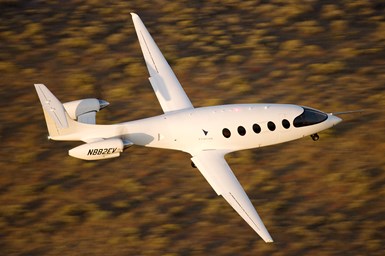GKN Aerospace, Materialise Partnering to Propel Additive Manufacturing in Aviation
Materialise supported the delivery of the additively manufactured wing tip for Eviation’s Alice, the world's largest all-electric aircraft, which made its maiden flight in 2022.
Materialise supported the delivery of the additively manufactured wing tip for Eviation’s Alice, the world's largest all-electric aircraft, which made its maiden flight in 2022. Photo Credit: Materialise
GKN Aerospace, a aerospace technology provider, and Materialise, a provider of 3D printing solutions and services, have signed a Letter of Intent (LOI) aimed at advancing the research, design and production of polymer additively manufactured (AM) parts for the aviation industry. The LOI was signed at the Paris Air Show and represents an extension of their successful collaboration.
Materialise has been a supplier of polymer AM to GKN Aerospace since 2015, and supported the delivery of the additively manufactured wing tip for Eviation’s Alice, the world's largest all-electric aircraft, which made its maiden flight in 2022.
Together, GKN Aerospace and Materialise aim to accelerate the certification of the AM process and push the boundaries of additive production of functional and flight-critical aerostructures, leveraging its manufacturing benefits.
The collaboration ranges from prototyping to the production of functional and flight-critical parts, aligning with the industry’s emerging sustainability trends and opportunities. In particular, the partnership will focus on electric vertical takeoff and landing (eVTOL) aircraft.
GKN Aerospace and Materialise’s collaboration has already enabled significant AM milestones, including the successful delivery and certification of multiple AM parts that are flying today. “This powerful alliance aims to leverage our combined expertise and the exceptional benefits of 3D printing to push the boundaries of innovation in the aeronautics industry,” says Jurgen Laudus, Vice President of Materialise Manufacturing. Together, the partners say they are are working to drive technological advancements, respond more effectively to customer requirements and shape the future of aerospace manufacturing.
“Materialise is a valued AM supplier for GKN Aerospace and partnering with them on this groundbreaking technology has been a success for both companies,” says Russ Brigham, GKN Aerospace program director. “AM is out there and flying on aircraft around the world today, and will be critical to achieve a more sustainable future of flight ahead.”
The potential for AM to revolutionize the aviation industry is significant, with the creation of lighter and stronger parts that were previously unachievable with conventional manufacturing technologies, while also offering time and cost reductions during the manufacturing process.
GKN Aerospace and Materialise bring complementary manufacturing experience across multiple AM printing technologies. Materialise has more than three decades of experience. It has helped pioneer the production of certified parts for various industries and provides EASA 21.G-certified flying parts, software solution and consultancy services for the aerospace industry. GKN Aerospace, a global technology provider in AM, has load-bearing AM structures certified and in serial production, as well as numerous other AM parts flying today for commercial, military, rotorcraft and space applications.
- Read this article about GKN Aerospace’s successful tests lightweight turbine rear structure. The company says an innovative design and manufacturing of shorter, lighter turbine rear structure can contribute to lower carbon emissions.
- Here’s information on how Materialise’s enhanced Magics Software enables traceability, connectivity and automation. The updated Magics workflow automation software helps improve product quality by creating an advanced digital thread connecting the entire manufacturing process.
Related Content
3D Printing Brings Sustainability, Accessibility to Glass Manufacturing
Australian startup Maple Glass Printing has developed a process for extruding glass into artwork, lab implements and architectural elements. Along the way, the company has also found more efficient ways of recycling this material.
Read MoreAlquist 3D Looks Toward a Carbon-Sequestering Future with 3D Printed Infrastructure
The Colorado startup aims to reduce the carbon footprint of new buildings, homes and city infrastructure with robotic 3D printing and a specialized geopolymer material.
Read MoreBMW Expands Use of Additive Manufacturing to Foster Production Innovations
The BMW Group is manufacturing many work aids and tools for its own production system using various 3D printing processes, with items such as tailor-made orthoses for employees, teaching and production aids, and large, weight-optimized robot grippers, which are used for such things as carbon fiber-reinforced polymer roofs and entire floor assemblies.
Read MoreCopper, New Metal Printing Processes, Upgrades Based on Software and More from Formnext 2023: AM Radio #46
Formnext 2023 showed that additive manufacturing may be maturing, but it is certainly not stagnant. In this episode, we dive into observations around technology enhancements, new processes and materials, robots, sustainability and more trends from the show.
Read MoreRead Next
3D Printed Polymer EOAT Increases Safety of Cobots
Contract manufacturer Anubis 3D applies polymer 3D printing processes to manufacture cobot tooling that is lightweight, smooth and safer for human interaction.
Read MoreCrushable Lattices: The Lightweight Structures That Will Protect an Interplanetary Payload
NASA uses laser powder bed fusion plus chemical etching to create the lattice forms engineered to keep Mars rocks safe during a crash landing on Earth.
Read MoreProfilometry-Based Indentation Plastometry (PIP) as an Alternative to Standard Tensile Testing
UK-based Plastometrex offers a benchtop testing device utilizing PIP to quickly and easily analyze the yield strength, tensile strength and uniform elongation of samples and even printed parts. The solution is particularly useful for additive manufacturing.
Read More





















